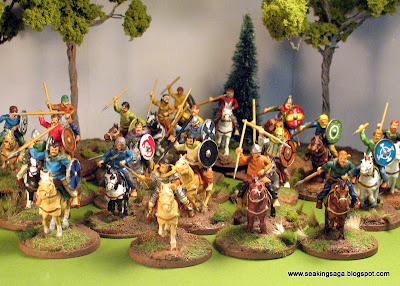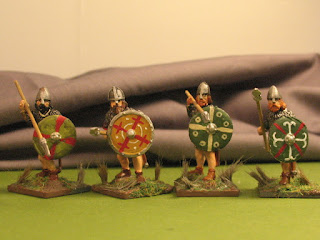Franks: The Battle Pool mechanic was one that I never quite understood when reading the early descriptions. When reading the book, it is not as complicated as it seemed. A player of the Franks has the ability to place up to three dice in the Battle Pool. The effectiveness of other abilities on the Battleboard depend on how many dice were allocated to the Battle Pool. This faction's challenge lies in the fact that one has to place dice in the Battle Pool, dice on abilities and still have enough dice left over to activate units. Players using the Franks will probably use larger units and depend on the We Obey rule. In fact, the Frankish hero Charlemagne can activate up to three units at a L distance as one of his special abilities. If you are like me, and like to play quick four or five point games, I am afraid the Franks would be of limited use in such situations.
Irish: Similar to the Welsh in that they are lightly protected fighters who must take advantage of the terrain, the Irish faction shows some serious modifications to the rules. Hero characters called the Curadh are able to operate independently of units and fight as individual warlords to a degree.
Norse Gael - A Viking faction, and like the Jomsvikings from the previous supplement, its variation is in giving the opposing player a choice. Instead of increasing wrath, the choice is a single combat challenge between a Norse Gael figure and an enemy figure. Winning the combat allows the Norse Gael player to unlock special abilities.
Strathclyde Welsh - a interesting faction choice, for it was a small kingdom that was eventually absorbed into Scotland in the early eleventh century. The units are not all required to be mounted as I previously assumed, but their new abilities depend upon mounted units. In this case, the new feature is off-table units. With proper activation, they can enter the battlboard from any side, and another ability allows them to make a shooting attack from off the board, if an enemy is within L of the table edge. Should SAGA move into the East, this would be a useful mechanic to handle steppe factions such as Seljuks or the Pechenegs.
The evolution of the rules in The Raven's Shadow does have the potential to slow the game down some, especially with the insertion of more Reaction based abilities, but that should decrease as players become more accustomed to the process. The faction choices are good, but one must decide what is right for their style of play. The Franks require an efficient and calculating manager. The Irish will be favored by the gambling player, who is willing to take a chance on big victories if a "6" can be rolled. The Norse Gael have some of the most interesting Hero abilities (Brodir of Man's seer powers seem quite fun) but Challenges may be gimmicky like the Jomsviking's wrath. My preferred faction from this update will most likely be the Strathclyde, because I am eager to see how the off table abilities play out.
Mounted Welsh kit bashed from two boxes of Wargames Factory Ancient Germans with Saxon and Viking heads and weapons. I added javelin quivers and green stuff cloaks to a few.
Not the paint work I am most proud of, but I did manage to complete about 18 mounted figures in a week. Pictured below is all 24, which is three points worth of warriors. Adding in a unit of levies and two hearthguards will be the final warband.





